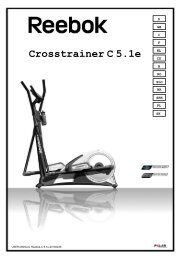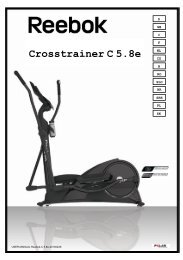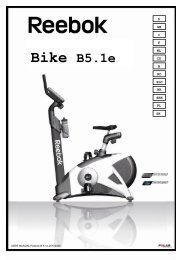by Body-Solid® - Fitness4all
by Body-Solid® - Fitness4all
by Body-Solid® - Fitness4all
Create successful ePaper yourself
Turn your PDF publications into a flip-book with our unique Google optimized e-Paper software.
EXERCISE<br />
PRESCRIPTION<br />
Sets<br />
Sets are defined as a combination of any number of reps of one exercise. The number<br />
of sets used in a workout is directly related to training results. Typically, two to three sets<br />
are used <strong>by</strong> intermediate and advanced lifters to achieve optimum gains in strength.<br />
Experts agree that multiple-set systems work best for the development of strength and<br />
muscular endurance. Gains will be made at a faster rate <strong>by</strong> using a multiple-set system<br />
than gains achieved through a single-set system. The use of a single set of an exercise is<br />
recommended and very effective for individuals who are untrained or just beginning a<br />
resistance training program. One-set programs might also be used for simple maintenance<br />
once you are in shape. It is important to note that low-volume set programs will<br />
increase strength in untrained individuals, but more complex physiological adaptations,<br />
such as gains in muscle mass, tone, size, and performance usually requires<br />
higher-volume set training for the best results. Multiple sets of an exercise present a<br />
more intense training stimulus to the muscles during each set. Once your desired<br />
initial fitness level has been achieved, multiple-set performances of the exercise using<br />
the proper resistance (with specific rest periods between sets) will take you to the next<br />
level of strength training, endurance, and muscular development.<br />
Resistance Used<br />
The amount of resistance used for a specific exercise is probably the most important<br />
variable in resistance training. When designing a resistance training program, a weight<br />
for each exercise must be chosen. The use of repetition maximums (RM): the exact<br />
resistance that allows only a specific number of repetitions to be performed, is probably<br />
the easiest method for determining a resistance. Typically, one uses a training RM target<br />
or a RM target zone. Example: If your RM zone is 8 to 12 repetitions and you cannot lift<br />
the weight at least 8 times using proper form, the weight is too heavy. On the other hand,<br />
if you can easily lift the weight 12 times, the weight is too light. In either case, the weight<br />
needs to be changed. As the strength level of the lifter changes over time, the resistance<br />
is adjusted so a true RM target or target zone resistance is used.<br />
Rest Periods Between Sets and Exercises<br />
One frequently overlooked variable in exercise prescription is the length of the rest<br />
period between sets and between different exercises. Your desired fitness goals will<br />
normally determine the amount of time you allow your body to rest. Exercises involving<br />
high repetitions (15 to 20) and a high number of sets (3 to 4) with short rest periods (30<br />
seconds) between sets will raise metabolic demands. This in turn will burn excess body<br />
fat and increase muscular endurance. Short rest periods are a characteristic of circuit<br />
weight training, and the resistances used are typically lighter. This type of workout is<br />
best for trimming body fat and toning muscle. Exercises with heavier resistance and<br />
fewer sets usually have a longer resting period between sets. The results of using this<br />
method are normally increased muscular strength and mass. If the desired outcome is<br />
to gain overall muscle mass, your exercise prescription should lean toward a higher<br />
weight resistance doing 2 to 6 repetitions per set, with a rest period of 3 to 4 minutes<br />
between each set.<br />
65<br />
Rest Periods Between Workouts<br />
The amount of rest between training sessions depends on the recovery ability of the<br />
individual. Most experts agree that three workouts per week with one day of rest between<br />
sessions allows adequate recovery, especially for the beginner. If the resistance training<br />
is not excessive, only moderate amounts of delayed muscular soreness should be<br />
experienced one day after the session. As the lifter advances and his or her body is<br />
better able to tolerate and recuperate from the resistance exercise sessions, the<br />
frequency of training can be increased. Well-conditioned athletes may be capable of,<br />
and need training frequencies of 4 to 5 days in a row to improve significantly and<br />
achieve their desired goals. When consecutive-training-day sequences are used, it is<br />
usually beneficial to do different exercises for the same muscle groups and use different<br />
resistances for the exercises. When training is performed on consecutive days, it often<br />
involves the use of a split routine (different body parts exercised each day), or a split<br />
program (different exercises for the same body part performed each day). There are<br />
many books available at the library or your local book store for the intermediate and<br />
advanced weight training enthusiast. It is also recommended that you work with a qualified<br />
personal trainer to achieve your ultimate goals.<br />
Order of Exercise<br />
Leaders in the field of strength and conditioning believe that working the larger muscle<br />
groups first (chest, back, legs), should take priority over training the smaller muscle<br />
groups (biceps, triceps, deltoids, calves). The reason behind this exercise order is that<br />
the exercises performed in the beginning of the workout are the ones that are going to<br />
require the greatest amount of muscle mass to perform. Hence, exercising the smaller<br />
muscle groups first will deplete the body of the energy necessary to stimulate the larger<br />
muscle groups. Arm-to-leg ordering allows for some recovery of the arm muscles while<br />
the leg muscles are exercised. “Stacking” exercises is a common practice among body<br />
builders as a way to attempt to bring about muscle hypertrophy. Stacking is loading<br />
up different exercises on the same muscle group (ie. standing bicep curls, preacher<br />
curls, one arm concentration curls). The exercise order will have a significant impact on<br />
the training stimulus stress level in a training session.<br />
Scheduling Training<br />
Finding the time to do it is one of the most difficult aspects of a training program. Once<br />
you have established a time to workout you should plan a training routine based on<br />
what muscles to involve on which day. As previously discussed, the larger muscle<br />
groups such as the chest, back, and legs should take priority over working the smaller<br />
muscle groups. Give your muscles at least 48 hours (but no more than 72 hours) of rest<br />
in between sessions.










